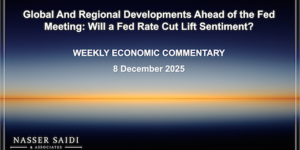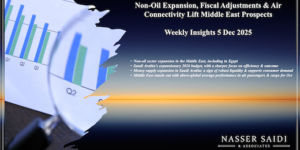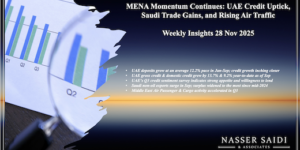MENA/ GCC Navigate Fiscal Deficits with Diversified Revenues and Digital Growth: Weekly Insights 18 Jul 2025
1. Financial Inclusion in the MENA region has improved from a decade ago, but the region has some of the widest gaps globally
- Account ownership in the MENA region has increased over time but is varied across the countries (decline in Algeria and Lebanon), according to the World Bank’s latest Global Findex report. Egypt is among the top eight countries globally with the largest number of unbanked (these eight comprise 53% of adults without an account).
- Adults without accounts are disproportionately women and poor adults. The most cited barriers are not having enough money, followed by the high cost of financial services.
- Gender gaps persist. There is a 15-percentage point (ppts) gap in the MENA, similar to Sub-Saharan Africa (12 ppts). This is more than twice average gap in low- & middle-income countries and vs 4 ppts globally.
- Age gap exists. with account ownership higher among older adults (i.e. age 25+). Global gap is 12 ppts vs 15 ppts in MENA and Sub-Saharan Africa. Worth noting that that a quarter of adults in MENA are aged 15-24.

2. MENA region saw the most dramatic growth in digital merchant payments, with the rate almost tripling since 2021
- The share of adults saving any money (be it formally or semi formally) has increased over time in the MENA region. However, the region is still the lowest across its regional peers. Gender gap is also the largest globally in the MENA region (13 ppts vs others ranging between 7-10 ppts).
- Sub-Saharan Africa performs better thanks to the popularity of mobile money accounts (23% of adults have a mobile money account). Mobile money accounts are less popular in the region but gaining share in Egypt. Iraq and Jordan.
- Only about 20% of borrowers in the MENA accessed formal credit in 2024: borrowing only from family or friends was the most common source.
- Digital payments in MENA surged, with the rate tripling (from a low base) to 26% of adults in 2024 (vs 42% globally). An important caveat – this is driven entirely by a 64 ppt increase in digital merchant payments in Iran. Excluding Iran, the average is just 7% (which would be the lowest).
- This includes a high rate of digitalization for government payments (over 80% of recipients being paid directly into an account) though this is not as prevalent in private sector wages (only 20% receiving a private sector wage payment are paid digitally). Need to hence leverage payment digitalisation to improve financial inclusion aspects.

3. Qatar’s fiscal deficit widened to QAR 757mn in Q2; H1 deficit accounts for only one-tenth the forecasted full-year deficit of QAR 13.2bn
- Qatar fiscal revenues grew 21.1% qoq to QAR 59.8bn in Q2; overall spending of QAR 59.847bn (+21.4% qoq) resulted in an uptick in budget deficit of QAR 757mn.
- H1 budget deficit of QAR 1.3bn is only one-tenth of the QAR 13.2bn deficit estimated in 2025 budget.
- In yoy terms, revenues eased by 0.1%. Oil and gas revenues fell by 19.9% qoq to QAR 34.0bn in Q2. Share of total revenues stood at 56.9%.
- Non-oil revenues surged almost four times to QAR 25.8bn in Q2. Non-oil revenues in H1 was more than three-fourths full year budgeted amount (QAR 43bn)!
- Total expenditures grew by 21.4% qoq and 5.7% yoy to QAR 60.6bn in Q2, of which 30% was wages and salaries while another 28.9% went towards major projects.
- Wages grew by 8.1% qoq while spending on major projects grew by 33.2% to QAR 17.5bn. Most spending categories in H1 clocked in between 50-60% of budgeted estimates for full year.

4. UAE federal net lending/ borrowing value narrowed to AED 15.1bn in Q1 2025
- UAE’s federal revenues fell by 19.7% qoq to AED 120.8bn in Q1 2025, as per the Ministry of Finance; in yoy terms, revenues inched up by 0.1%. Tax revenues slipped by 20.3% qoq and 10.6% yoy to AED 75.2bn in Q1 2025, but accounted for 62.3% of total revenues.
- Spending grew by 15.5% yoy to AED 105.7bn in Q1 2025; compensation of employees up 2.3% to AED 31.0bn (or 29.3% of total spending) though it declined by 4.5% qoq. Subsidies fell one-third from Q1 2024 to AED 2.3bn.
- Net lending/ net borrowing stood at a surplus of AED 15.1bn in Q1: almost half the surpluses of AED 29.1bn in Q1 ‘24 and AED 28.3bn in Q4 ‘24.
- UAE launched its 2027-29 budget cycle this week, projected to reach AED 900bn (same as the previous four consecutive cycles), will integrate AI into the process and highlight a performance-based approach. Also disclosed was that public debt levels were stable at AED 62.1bn of Jun 2025.

5. Consumer price inflation in Saudi Arabia stood at 2.18% yoy in H1 2025 (vs 1.6% in H1 2024); producer price inflation halves to 1.68%
- Consumer price inflation in Saudi Arabia held almost steady at 2.27% in Jun (May: 2.22%), as prices eased in food & beverages (1.53% vs May’s 1.59%), housing & utilities (6.5% vs 6.8%) and restaurants & hotels (1.64% from 1.8%) while recreation & culture prices edged up (0.05% from -0.58%). Housing costs eased slightly in Mar (6.5% from 6.8%) as rental costs slowed (7.6% from 8.1%).
- Five major categories (of out 12) clocked in deflationary readings, of which prices dropped further in health (-0.34% from -0.18%) while all others saw the pace of decline slow including in transport (-0.72% from -0.78%).
- CPI averaged 2.18% in H1 2025 vs 1.61% in H1 2024, with the increase stemming from food & beverages (1.54% from 1.09%). Housing & utilities remained the highest across all components but eased to an average 7.03% from 8.49% in H1 2024; recreation & culture costs fell further (-0.59% vs -0.3%) while miscellaneous goods and services prices accelerated: up by 3.77% in H1 2025 vs -0.73% a year ago.
- Wholesale prices in Saudi Arabia moved up for the third consecutive month, to 2.1% in Jun (May: 2.04%), due to upticks in agriculture & fishery (4.38% vs 4.35%) and other transportable goods (4.45% from 4.31%); deflation continued in ores & minerals (-1.13% from -1.46%).
- Average wholesale prices more than halved to 1.68% in H1 2025 (vs H1 2024: 3.49%), as prices of “other transportable goods” plunged (3.5% vs 8.53%), in addition to “metal products, machinery & equipment” (-0.28% vs -0.51%) and food products (0.07% vs 2.05%); costs of agriculture & fishery surged (4.22% from -0.17%).

6. Foreign US Treasury holdings stay USD 9.0trn+ for the third month in a row in May; Kuwait jumped to another record-high while Saudi & UAE stay 17th & 19th largest holders globally
- Foreign holdings of Treasuries edged up by 0.4% mom and 11.2% yoy to USD 9.045trn in May – this is lower than Mach’s record USD 9.05trn – partly due to the increase in Canada’s purchases.
- Japan and UK were the largest two nations holding US Treasuries (at USD 1.14trn and USD 809.4bn respectively), while China’s holdings of Treasuries declined for the fourth month in a row to USD 756.3bn, the lowest since Mar 2009.
- Canada Treasuries holdings surged 16.7% mom to USD 430.1bn in May, more than reversing the Apr position of being the biggest sellers (-13.5% mom).
- Saudi Arabia remained the 17th largest global investor in May: though its holdings declined by 4.6% mom and 6.3% yoy to USD 127.7bn.
- UAE holdings declined by 8.24% mom to USD 103.6bn – 19th largest holder of US Treasuries (behind Saudi Arabia and South Korea, but ahead of Germany). However, in yoy terms, UAE holding were up by 46.3%.
- Kuwait posted a gain of 5.2% mom & 23.4% yoy to a new record-high USD 57.02bn in May (previous high: USD 54.2bn Apr 2025).
Powered by:









